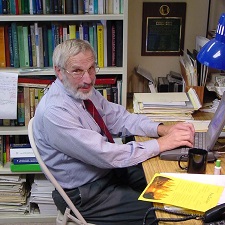
Michael G. Barbour
Professor of Plant Sciences, Emeritus
What comes to the mind of a plant ecologist when the name Michael Barbour is mentioned? Larrea, Cakile, coniferous forests, vernal pools, Terrestrial Plant Ecology, Terrestrial Vegetation of California, indefatigable field researcher, enthusiastic teacher, irreplaceable friend? All of that and much more crossed our minds when we learned that, after a long fight with Lewy body-Parkinson’s disease, Mike died peacefully at his home in Winters, California, on January 7. He is survived by his wife Valerie Whitworth, daughter Julie Barbour, son Alan Barbour, stepson Steven Whitworth, five grandchildren and generations of grateful colleagues and students.
Michael was born to George and Mae Barbour on 24th of February, 1942, in Jackson, Michigan. After graduating with a BS in Botany from Michigan State University in 1963, he went on to obtain his PhD in Botany from Duke University in 1967. The same year, Michael was hired as an assistant professor in the Department of Botany, University of California, Davis (UCD). For the following half century, plant ecology in California has been unimaginable without Professor Michael Barbour.
The variety of his research was extensive. He studied almost all types of ecosystems in the state. After working on population structure and ecophysiology of creosote bush in the Mojave Desert, Michael studied salt tolerance and competiveness of Californian salt marsh plants, vegetation of coastal dunes and beaches along the Pacific coast, demography of endemic plants in the Eureka Valley, vegetation of the Alabama Hills under Mt. Whitney, regeneration of red and white fir in the Sierra Nevada and the northern Coastal Range, old-growth forests of the Lake Tahoe Basin, conifer forests in the San Bernardino Mountains, and vegetation of vernal pools in the Central Valley. His major questions were always “What determines distribution of individual plant species?” and “What is responsible for the uniqueness of particular plant communities?”
Michael’s long professional career was not focused solely on California. He studied seed banks in four vegetation types in South Australia, morphology and cytology of creosote bush in Argentina, dune and scrub vegetation in Israel, beach vegetation along the Gulf of Mexico, mixed-forests in the Baja California’s Sierra San Pedro Martir, age structure of Quercus pyrenaica woodlands in Spain, vernal pools in Portugal, and population structure of Pinus canariensis stands on the island of Tenerife.
While Michael’s research contributions are extensive, his teaching and textbooks also have had a far-reaching influence. Michael taught introductory Botany/Plant Biology, often in partnership with others. To assist his teaching, he co-authored two Botany/Plant Biology textbooks in several editions and one of them, Botany: An Introduction to Plant Biology, was for a time the best-selling text on that topic in the US. He also routinely taught an undergraduate course on California plant communities. Students loved this class and all of them still remember field trips that helped them to see Californian nature in a completely new way. The graduate course on Plant Community Ecology, taught with John Menke and Marcel Rejmánek, was definitely more demanding, but students did not complain and handouts provided in this class are still used as reference by many.
Michael was a leading author of three editions of the textbook Terrestrial Plant Ecology. For many years, this was the only textbook on the subject that was available. He also co-edited Terrestrial Vegetation of California, together with his mentor and colleague Jack Major, and with his former major professor at Duke University, W. Dwight Billings, Michael coedited two editions of Vegetation of North America. In the years 1985 – 1988, Michael served as an editor for Ecology/Ecological Monographs published by the Ecological Society of America. Browsing through popular books on California’s flora and vegetation co-edited by Michael (e.g., California’s Changing Landscapes or California’s Botanical Landscapes) will be enjoyed by both lay and professional readers for many years to come.
He served on the International Association for Vegetation Science (IAVS) Council for two terms from 2007 to 2015. He was also a long-time member of the North American Section of IAVS and served as Chair of the Section from 2000 to 2003. Mike and Jack Major organized a 1988 IAVS Field Conference focused on California coastal vegetation. Mike was a frequent participant in IAVS meetings and excursions. Many of us met him in 1995 (Houston, USA), 1998 (Uppsala, Sweden), 1999 (Bilbao, Spain), 2002 (Porto Alegre, Brazil), 2004 (Kona, Hawaii), 2005 (Lisbon, Portugal), 2007 (Swansea, Wales), 2008 (Stellenbosch, South Africa), 2009 (Crete, Greece), 2010 (Ensenada, Mexico), 2011 (Lyon, France), 2012 (Mokpo, South Korea), 2013 (Tartu, Estonia), 2015 (Brno, Czech Republic), 2017 (Palermo, Italy), and 2018 (Bozeman, Montana).
I don’t remember Michael ever criticizing anybody. Once he told me “I don't like to compare people.” This attitude was one of the reasons all of us loved him. He had several “eternal” students who, because of his patience and encouragement, made it to their graduations even after a very long time.
We lost a great mind and a unique friend too soon. Michael’s friends and colleagues around the world will sorely miss him, but his achievements and achievements of his students guarantee him a permanent place in the annals of the science of vegetation.
Michael’s family has asked that donations in his name could be made to the UC Davis Center for Plant Diversity Herbarium.
Rejmánek, Marcel (2021)
From the Mojave Desert to the Sierra Nevada: Michael G. Barbour (1942-2021). IAVS Bulletin 2021/1, 34-37.
